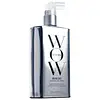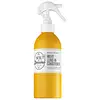What's inside
What's inside
 Key Ingredients
Key Ingredients

No key ingredients
 Benefits
Benefits

 Concerns
Concerns

No concerns
 Ingredients Side-by-side
Ingredients Side-by-side

Water
Skin ConditioningDipropylene Glycol
HumectantPolysilicone-29
Silicone Quaternium-18
EmollientGlycerin
HumectantTrideceth-6
EmulsifyingChamomilla Recutita Flower Extract
MaskingCalendula Officinalis Flower Extract
MaskingPotassium Sorbate
PreservativePhenoxyethanol
PreservativeTrideceth-12
EmulsifyingSodium Benzoate
MaskingChlorphenesin
AntimicrobialPotassium Benzoate
PreservativeDisodium EDTA
Citric Acid
BufferingWater
Skin ConditioningGlycerin
HumectantParfum
MaskingStearyl Alcohol
EmollientCoconut Alkanes
EmollientCocoglucosides Hydroxypropyltrimonium Chloride
CleansingCetyl Alcohol
EmollientBehentrimonium Methosulfate
Bertholletia Excelsa Seed Oil
EmollientTheobroma Grandiflorum Seed Butter
Skin ConditioningOrbignya Oleifera Seed Oil
EmollientAstrocaryum Tucuma Seed Butter
EmollientTocopherol
AntioxidantCoco-Caprylate/Caprate
EmollientLactic Acid
BufferingGardenia Jasminoides Fruit Extract
Cosmetic ColorantHydrolyzed Gardenia Florida Extract
AntioxidantButylene Glycol
HumectantMaltodextrin
AbsorbentPhenoxyethanol
PreservativeIsohexadecane
EmollientSodium Hydroxide
BufferingLimonene
PerfumingBenzyl Alcohol
PerfumingCoumarin
PerfumingBenzyl Salicylate
PerfumingHydroxycitronellal
PerfumingWater, Glycerin, Parfum, Stearyl Alcohol, Coconut Alkanes, Cocoglucosides Hydroxypropyltrimonium Chloride, Cetyl Alcohol, Behentrimonium Methosulfate, Bertholletia Excelsa Seed Oil, Theobroma Grandiflorum Seed Butter, Orbignya Oleifera Seed Oil, Astrocaryum Tucuma Seed Butter, Tocopherol, Coco-Caprylate/Caprate, Lactic Acid, Gardenia Jasminoides Fruit Extract, Hydrolyzed Gardenia Florida Extract, Butylene Glycol, Maltodextrin, Phenoxyethanol, Isohexadecane, Sodium Hydroxide, Limonene, Benzyl Alcohol, Coumarin, Benzyl Salicylate, Hydroxycitronellal
 Reviews
Reviews

Ingredients Explained
These ingredients are found in both products.
Ingredients higher up in an ingredient list are typically present in a larger amount.
Glycerin is already naturally found in your skin. It helps moisturize and protect your skin.
A study from 2016 found glycerin to be more effective as a humectant than AHAs and hyaluronic acid.
As a humectant, it helps the skin stay hydrated by pulling moisture to your skin. The low molecular weight of glycerin allows it to pull moisture into the deeper layers of your skin.
Hydrated skin improves your skin barrier; Your skin barrier helps protect against irritants and bacteria.
Glycerin has also been found to have antimicrobial and antiviral properties. Due to these properties, glycerin is often used in wound and burn treatments.
In cosmetics, glycerin is usually derived from plants such as soybean or palm. However, it can also be sourced from animals, such as tallow or animal fat.
This ingredient is organic, colorless, odorless, and non-toxic.
Glycerin is the name for this ingredient in American English. British English uses Glycerol/Glycerine.
Learn more about GlycerinPhenoxyethanol is a preservative that has germicide, antimicrobial, and aromatic properties. Studies show that phenoxyethanol can prevent microbial growth. By itself, it has a scent that is similar to that of a rose.
It's often used in formulations along with Caprylyl Glycol to preserve the shelf life of products.
Water. It's the most common cosmetic ingredient of all. You'll usually see it at the top of ingredient lists, meaning that it makes up the largest part of the product.
So why is it so popular? Water most often acts as a solvent - this means that it helps dissolve other ingredients into the formulation.
You'll also recognize water as that liquid we all need to stay alive. If you see this, drink a glass of water. Stay hydrated!
Learn more about Water